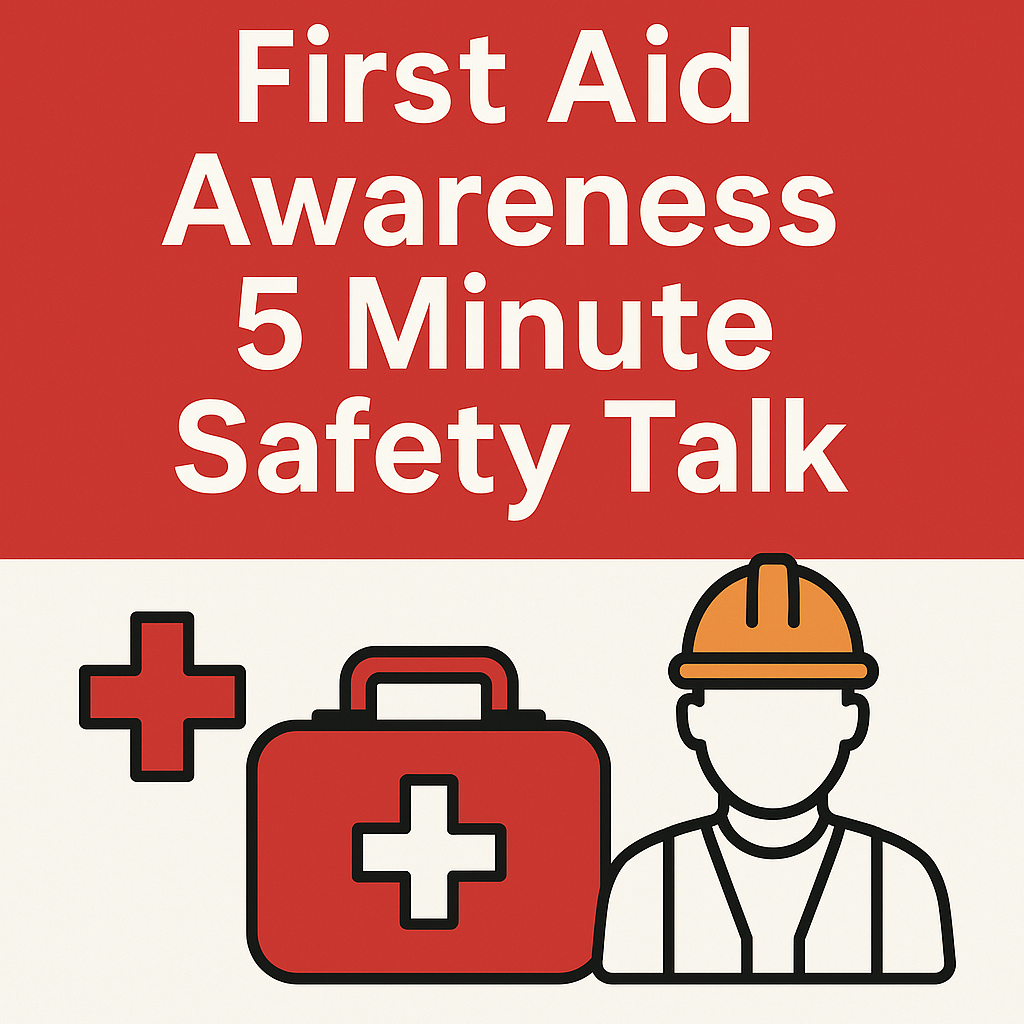
First Aid Awareness 5 Minute Safety Talk
Good Morning Team,
Today, we’re taking five minutes to talk about something that can truly make a difference in the critical moments after an injury: First Aid Awareness.
Accidents can happen anywhere — on a construction site, in a warehouse, or even in the office. And when they do, knowing how to respond quickly and effectively can be the difference between a minor incident and a major emergency.
You don’t have to be a doctor to make a life-saving impact — you just need basic first aid knowledge and the confidence to act.
What is First Aid?
First aid is the immediate care given to an injured or ill person before professional medical help arrives. It’s not about replacing emergency services — it’s about stabilizing the person, preventing the condition from worsening, and potentially saving lives.
Why First Aid Awareness Matters
- It helps reduce the severity of injuries
- It keeps the victim stable until help arrives
- It can stop bleeding, restore breathing, or prevent infection
- It increases survival rates during emergencies
Would you rather stand by helplessly, or be the one who knows what to do?
Common Workplace Incidents Requiring First Aid
- Cuts, scrapes, or bleeding wounds
- Burns from hot surfaces or chemicals
- Slips, trips, and falls causing fractures or sprains
- Eye injuries from flying particles or chemicals
- Electric shock
- Heat exhaustion or fainting
These might sound scary, but you can handle many of them with basic first aid steps.
What Should Be in a First Aid Kit?
A proper first aid kit should be easy to access and contain:
- Sterile gauze pads
- Adhesive bandages (Band-Aids)
- Antiseptic wipes
- Burn ointment
- Scissors and tweezers
- CPR face shield
- Disposable gloves
- Eye wash solution
- Emergency blanket
- Pain relievers (non-prescription)
- First Aid manual
Make sure your workplace kit is checked regularly and always stocked.
Basic First Aid Principles Everyone Should Know
1. Check the Scene for Safety
Make sure the area is safe for both you and the injured person. Don’t rush into a dangerous situation.
2. Call for Help
Dial emergency services (like 112/911) as needed. Time is critical.
3. Care for the Victim
Depending on the injury:
- For bleeding: Apply pressure and elevate the wound
- For burns: Rinse with cool water — don’t use ice
- For broken bones: Immobilize and support the limb
- For choking: Use the Heimlich maneuver
- For CPR: 30 compressions to 2 rescue breaths (if trained)
4. Stay Calm and Reassure the Victim
Fear and panic can worsen the situation. Speak gently and stay with the person until help arrives.
Quick Tips to Remember
- Always wear gloves to avoid contact with blood or fluids
- Never move a seriously injured person unless absolutely necessary
- Don’t give food or drink to someone who is unconscious
- Use an AED (Automated External Defibrillator) if available, in cardiac emergencies
- If unsure what to do — do your best and wait for help
Real-World Example
In one case on a construction site, a worker fell from a ladder and began bleeding heavily from a leg wound. Thanks to a teammate who used the pressure and elevation method, bleeding was controlled and the worker recovered fully. First aid saved his leg — and potentially his life.
First Aid Is Everyone’s Responsibility
You don’t need to be a safety officer to care about safety. Every team member should:
- Know the location of first aid kits
- Understand basic first aid steps
- Attend refresher training when available
- Stay alert to hazards that can lead to injury
Summary – What You Should Now Know
- First aid means immediate care before professional help arrives
- It can stabilize, reduce severity, and save lives
- Everyone should know basic steps like stopping bleeding, CPR, and treating burns
- Keep kits stocked and accessible
- Stay calm and act — your response matters
Manual Handling 5 Minute Safety Talk
Scaffold Safety 5 Minute Safety Talk
Lockout and Tagout – LOTO 5 Minute Safety Talk
Chemical Handling 5 Minute Safety Talk
Hot Work Safety 5 Minute Safety Talk
5 Unique FAQs
Q1: Do I need a certificate to give first aid?
No — anyone can provide first aid. Certification is helpful but not mandatory in emergencies.
Q2: How often should I refresh my first aid training?
Every 2–3 years is recommended, or sooner if workplace conditions change.
Q3: Can I be held liable for giving first aid?
In most regions, Good Samaritan laws protect helpers acting in good faith.
Q4: What should I do if I forget a step?
Stay calm, do your best, and focus on stopping the bleeding, breathing, and calling help.
Q5: Should a first aid kit include medications?
Only non-prescription items like antiseptic, burn gel, and pain relievers should be included. Leave prescriptions to the pros.